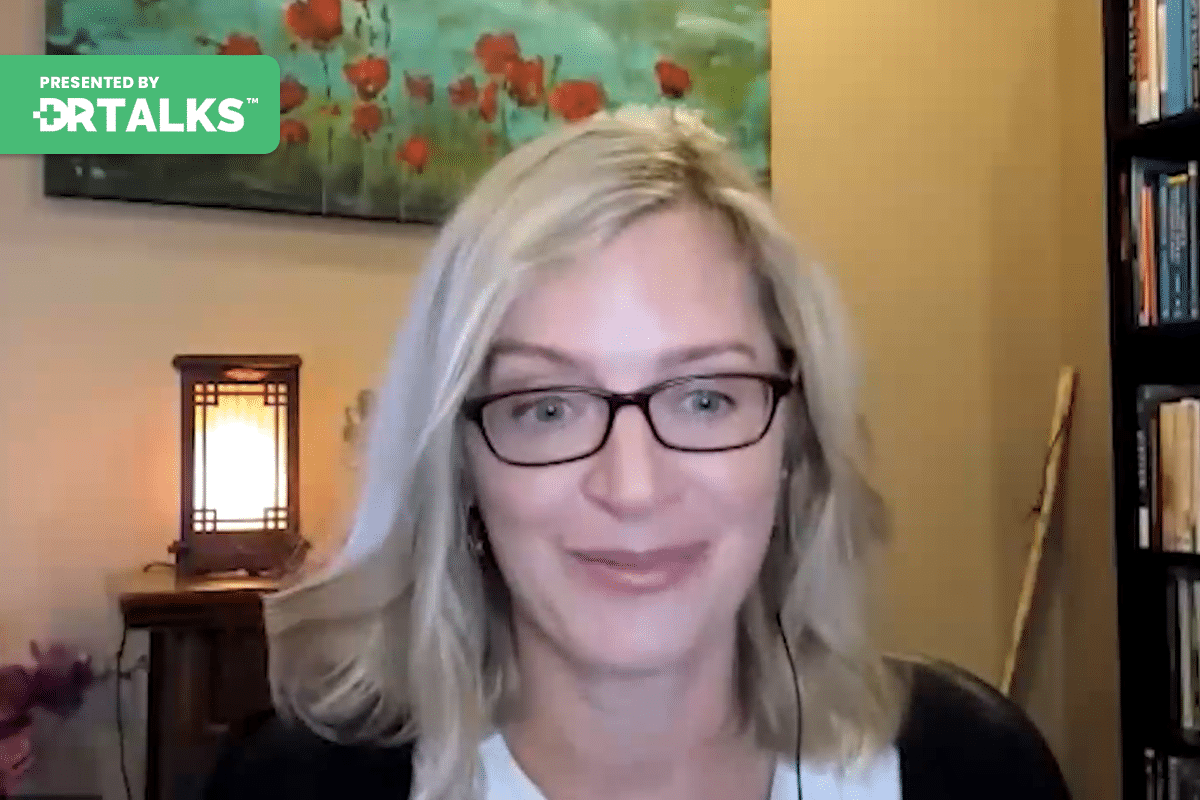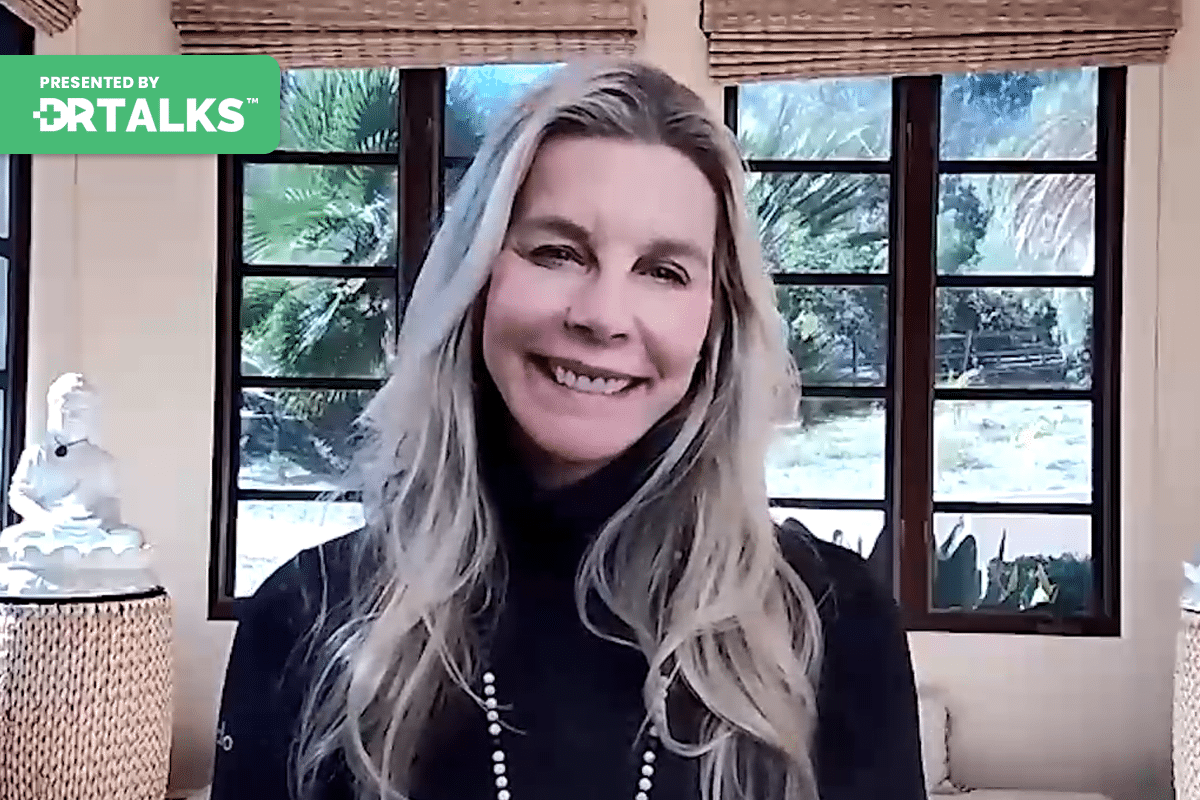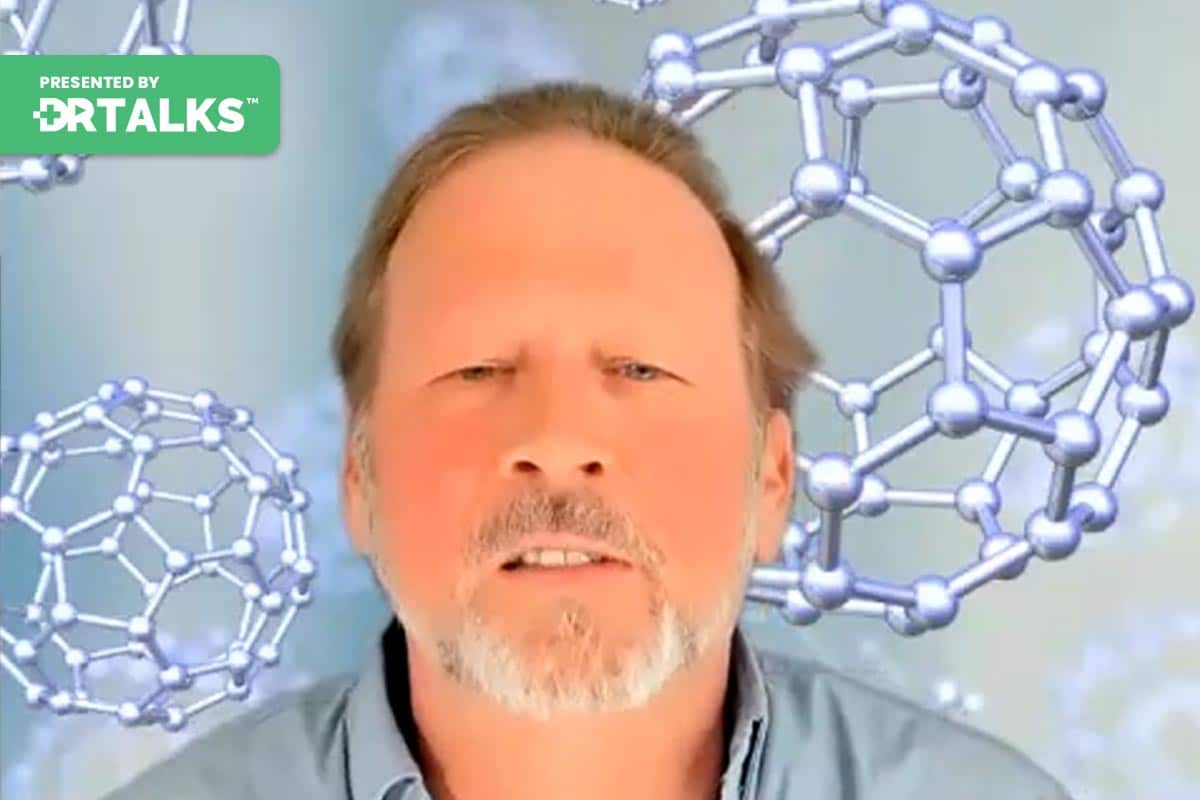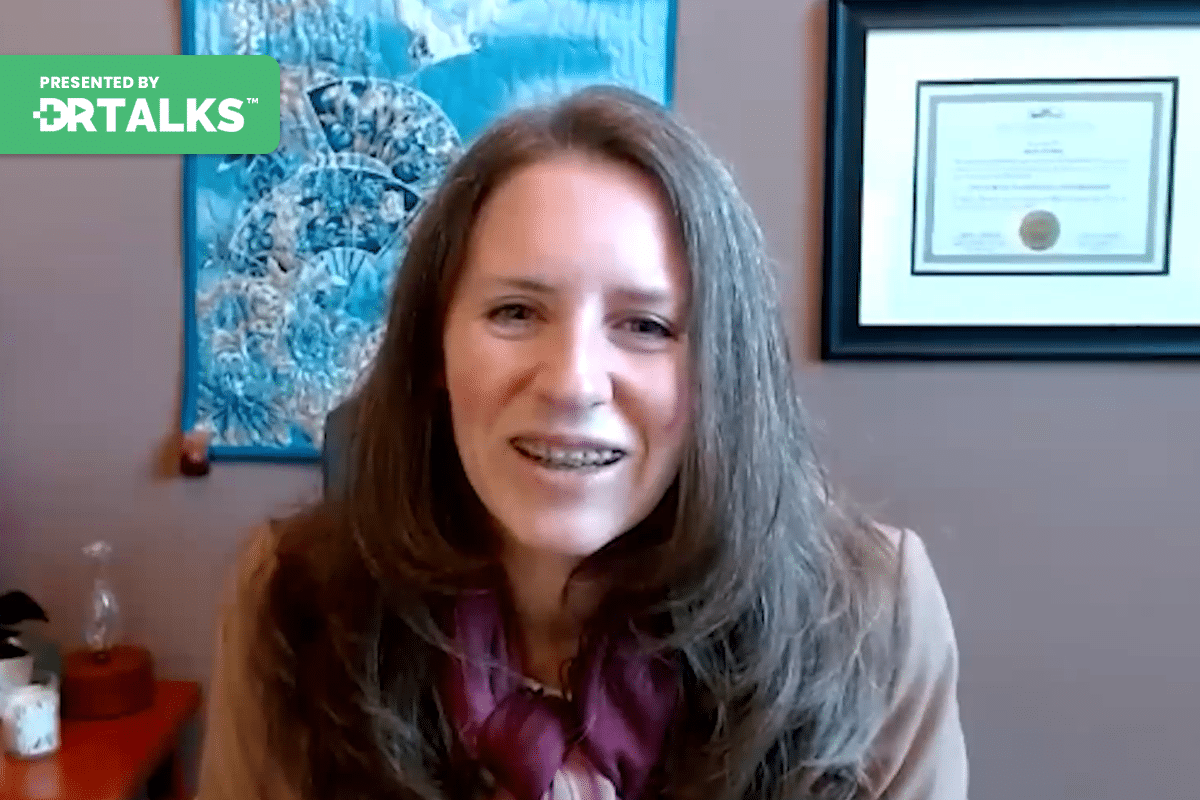Join the discussion below

Dr. Darin Ingels is a Licensed Naturopathic Doctor, Author, International Speaker, and leading authority on Lyme disease. He is a former Lyme patient who overcame his own 3-year battle with Lyme disease, after having failed conventional treatment and became progressively debilitated. Dr. Ingels found that proper diet, lifestyle management and... Read More

Kelly McCann, MD, passion for understanding why certain people develop specific conditions drove her beyond conventional medicine to study first Complementary and Alternative Medicine, then Integrative Medicine, Functional Medicine, and Environmental Medicine, which led to an exploration of chronic infections and illness due to mold exposure. As a practicing Internal... Read More
- Lyme disease and other tick-borne illnesses can create an imbalance in the immune system
- This imbalance can lead to mast cell activation and other autoimmune disorders
- Learn about the latest ways to stop histamine and other substances from creating systemic inflammation and making your allergies/sensitivities worse
Related Topics
Allergies, Anxiety, Autoimmune Disease, Bladder Symptoms, Bloating, Cardiac Symptoms, Chest Pain, Constipation, Depression, Diarrhea, Fatigue, Gas, Gastrointestinal Symptoms, Headaches, Hives, Hormonal Dysregulation, Immune Dysfunction, Immune Mess, Immune System, Immune System Sensitization, Inflammation, Itching, Joint Pains, Limbic System Retraining, Lyme, Mast Cell Activation, Mcas, Mold Exposure, Mold-triggered Symptoms, Muscle Aches, Neurological Symptoms, Palpitations, Peripheral Neuropathy, Psychiatric Symptoms, Rashes, Symptoms, Vagus Nerve StimulationDarin Ingels, ND
Welcome back, everyone, to the Lyme summit. And I’m really thrilled that you’re joining us today because our guest is a personal friend and really one of the brightest doctors I know, Dr. Kelly McCann. She’s board certified in internal medicine, pediatrics, functional medicine has two master’s degrees and tropical medicine and public health and a certificate in spirituality. I mean, I go to her office and her walls just filled with certificates. So, Kelly, I’m just so happy that you’re joining us on the summit today.
Kelly McCann, MD
Thank you so much for having me. Darin, it’s always a delight to spend time with you.
Darin Ingels, ND
So I always like to I think it’s interesting for people to understand, you know, kind of like your, you know, purpose, you know, why you do what you do. And I know you and I have very similar practices. We see a lot of people with Lyme disease. We saw a lot of people with mild illness. But you know, what kind of brought you to do what you do today?
Kelly McCann, MD
Very good question. You know, I always wanted to be able to figure out the mysteries. Right. It was the patients who just had all these presentations. They felt so sick and I. I felt this calling to really try and figure it out for them. And I also experienced a lot of it myself. Right. I grew up in upstate New York. I was mold exposed multiple times and got sick myself and had many symptoms that are associated with mass activation as well. Lots of allergies. I was really allergic, kid. I started getting hives after a mold exposure or bloating, you know, the whole thing. And so it’s not just been a passion to help people, but to also, you know, help myself heal my own myself and then be able to give back. So it’s really a combination of things that has driven it, and it’s so wonderful to be able to have patients come back and be like, Oh, my gosh, thank you so much. I, you know, I’m so much better. I just love that that feed that feeds me to be able to explore more and figure out other ways of doing things to keep helping the people that are yet better.
Darin Ingels, ND
Well, you know, for those of us who’ve dealt with our own personal health issues, I mean, obviously it’s a driving force. Again, behind what we do. We do. And I know one of your wheelhouse is, is this thing called mast cell activation. You alluded to that a little bit earlier. And I want to really do a deep dove today on, you know, mass and allergy, because so many of our Lyme patients and tick borne illness at some point end up experiencing some element. So can you just talk a little bit about, you know, what is this thing called m gas and how does it look like, you know, what kind of symptoms will people experience?
Kelly McCann, MD
Yes. This the symptoms can be very varied, which makes it a little bit tricky. However, we think about let me back up a little bit. Let’s talk about what mast cells are. So mast cells are a part of your immune system. It’s an innate part of your immune system. The mast cells are like a red blood cell, white blood cell. They’re born in the bone marrow. And then they move and they line the periphery. So they line our sinuses and our upper respiratory tract, and they live on our gastrointestinal tract ladder. They’re actually in the brain and they hang out around our blood vessels and our nervous system, our nerve cells and our skin, of course. And they’re job is to to survey the area and identify if there’s a foreign invader or some sort of threat, some sort of toxin. And when they perceive a threat, then what they do is they release these little packages of chemical messengers that we call mediators. And these mediators are filled with inflammatory chemicals, cytokines. You know, we’ve now heard of the cytokine storm with COVID.
Most people know that there are other cells in the body that make cytokines, but mast cells are one of the primary ones that make these cytokines and they release these cytokines and chemical messengers and inflammatory mediators in response to a threat. And when they do that, they hopefully fight the threat. But what happens in some genetically lucky people is that once that threat dissipates, they may still have a mistaken signal that there’s a threat there. And they keep releasing those mediators. And so even when we’re exposed to things that we should not normally react to, like our neighbors cat, you know, trees, pollen and mold spores and the food that we eat or, you know, somebody’s perfume, we can still have reactions. And those reactions are allergic, inflammatory in nature. And they tend to involve multiple systems in the body.
And so you can have allergies and have like a runny nose and you won’t necessarily have Marcell activations under them. But also activation syndrome refers to that multi-system multi-symptom allergic inflammatory response and so similar I’m sorry, some symptoms that would be associated with nasal activation syndrome could be fatigue, muscle aches and pains, joint pains, headaches, all of the allergic symptoms, of course, hives, rashes, itching, and then cardiac symptoms, palpitations, chest pain, neurological symptoms, nerve, peripheral neuropathy. You can get psychiatric symptoms, anxiety, depression, gastrointestinal symptoms are very, very common. Bloating, gas, diarrhea, constipation, bladder symptoms. Some women get pelvic symptoms, hormonal dysregulation, things like that. So as you can see, a person can have all sorts of symptoms and still have massive activation.
Darin Ingels, ND
You know, I don’t know what your observation is, but, you know, it seems to me that I see so many people in my practice that they never had an allergy sensitivity or anything. And then after they get Lyme or other tick borne illness, now they become hypersensitive to their whole world. Food bothers them, mold bothers them, chemicals bother them. Is that something that you’re seeing in your practice as well?
Kelly McCann, MD
Yes, absolutely. I do find that, you know, if you dig deep enough, they may have had some symptoms when they were younger, maybe, you know, maybe some irritable bowel symptoms, maybe a little bit of like seasonal allergies or maybe they come from families who had reactions or who had allergies, not all the time, but certainly Lyme tick borne illness, mold, especially these things trigger that muscle activation syndrome.
Kelly McCann, MD
And the studies tell us that roughly 20%, I think it’s 17%, but we’ll say 20% of the population, according to these studies, have massive activation. That’s huge.
Darin Ingels, ND
That’s a lot of folks.
Kelly McCann, MD
Yeah.
Darin Ingels, ND
Well, I think it’s particularly relevant for those who are tuning in here because again, I find so many people that have tick borne illness at some point, you know, we end up having to deal with these mast cell issues. And again, my experience, you know, is even if we’re successful at eradicating Lyme or at least controlling the symptoms, we still often see that you’re left with this immune mess. You know, that you still have this activation. It’s like once your immune system kind of gets sensitized, you know, we stop the trigger now or at least one of the triggers, but that those symptoms tend to persist. You know, what do you think’s going on there? What is it about Lyme and these infections that seem to set the immune system off? Do we really know or is it still a bit of a mystery?
Kelly McCann, MD
I think it’s still a little bit of a mystery. And my sense about it is that, you know, the muscle activation piece can also be complicating and getting people better from Lyme and tick borne illness, too. So in a lot of circumstances, I’m spending much of my time even before we’re able to do treatment to try and ratchet down the reactivity. And we can talk about the different things that will help with that. And, you know, and so then people will learn over the course of their treatment how to help themselves navigate these triggers a little bit better. Which does help on the back side, too, once you kind of gotten their Lyme symptoms under control. And I do think it is possible to have the whole immune system come back down, but it requires more than just taking supplements. So what happens with these mast cells is that they’re responding to the internal not just the, you know, like the infection itself or the mold or the toxin. They’re also responding to our own internal sense of lack of safety. And so some of the things that we can do to help with mitigating those mast cell symptoms are vagus nerve stimulation where we’re quite, you know, in stimulating the vagus nerve to get us out of fight or flight or freeze and into parasympathetic, which is where we can actually heal. And we can also do limbic system retraining and kind of working on the activation of the brain and the nervous system that is so wired for the stress response.
Darin Ingels, ND
Yeah, it’s so complicated. I think it’s an important distinction that if you have Lyme disease or other tick borne illness and you have massive activation, sometimes it’s really challenging to distinguish which symptoms are related to Lyme, which symptoms are related to massive activation. And I know you and I both, I see similar populations that a lot of our Lyme patients are dealing with mold, which is a major trigger of mast cell activation. And, you know, sometimes clinically I think it’s impossible to distinguish, you know, which symptoms are related to which. And, you know, I’ve had this discussion with Neil Nathan, you know, one of the mold experts out there who really prefers to treat mold before you deal with Lyme disease. And not that both aren’t a problem, but because of so much clinical overlap, you know, dealing with mold first. I know he feels like as a way to help at least tease out which symptoms are mold driven versus which symptoms are Lyme driven.
And, you know, everyone’s different and you know, the percentage to which each affects you is going to vary. But I just think, you know, for those tuning in today, you know, just understand that it’s complicated. And, you know, we as your doctor are trying to help, you know, tease out again what’s related to what. But in reality, you know, often we’re dealing with multiple factors. You know, we’re trying to treat ear infection. We’re trying to get your muscles under control or trying to control your toxicity. So if you’re wondering, like, oh, my gosh, I’m doing all these different tasks and I’m doing all these different treatments. It’s because we’re trying to, you know, wrangle in all these different aspects that we know are adversely affecting your health. So it’s complicated.
Kelly McCann, MD
It is complicated. And you know, what I tell my patients and what I would tell your listeners is the more participatory you can be in your care, journaling, taking notes, paying attention, being as scientific as you can about things, the better you’ll be able to help your practitioner sort this all out because we don’t have a crystal ball. We don’t know exactly which, you know, which column to put your symptoms in. As you heal, you’ll be better able to tell us like, okay, that migraine is really my Marcel and my irritable bowel symptoms is really the leaky gut from the mold. And now that it’s healed, that’s gone right? And it’s not a mass reaction. So it’s a partnership of really learning together. And for you as the patient on your health journey, doing your due diligence to, to understand your own body, your own physiology and how it’s working. When you take certain medications and take certain supplements and work on your progress, that you provide that information. And then we can use that information as a provider to really help figure out your next steps. Right. Because it’s just a journey.
Darin Ingels, ND
Absolutely. And sometimes it’s a longer journey. You know, I know my expectation is that, you know, when we start a course of treatment, you know, it may take time to get over the hurdle, but we do expect to see improvement along the way. You know, I think one of the most frustrating things as a patient is, I mean, I’ve experienced as a line patient myself, you know, when you’re starting a treatment and you’re not seeing the improvement and in some cases you’re getting hurt saying you’re getting die off reaction and you actually feel worse. So like you said, I think this is important to have good communication with your health care provider. You’re giving that feedback because that helps guide us whether we need to adjust your dose or whether we need to change your treatment protocol. So like I said, I just agree that keeping good notes, good keen observation on how you’re reacting in different situations really helps us. You know, guide your treatment and make sure we’re doing the best thing we can for you.
Kelly McCann, MD
Absolutely.
Darin Ingels, ND
So I want to talk a little bit about, you know, treatment. You know, when people say, okay, we’ve just seren I remember I said before we jump on that, maybe just a quick thing on testing, because I know testing is a little bit variable. Can you just talk a little bit about, you know, what tests are available and what’s the reliability of these tests?
Kelly McCann, MD
Sure, I’m happy to. And in order to do this, we really need to talk about the type of practitioner you might see if you think that you have nasal. So I’m in what we call consensus to camp, which is along with Dr. Lawrence, Afrin, Dr. Neal, Nathan, Dr. Tanya Dempsey and Dr. Theodora’s. And we understand that the presentation and the labs that we can look at, we really have to rely on the presentation. And so in many ways, muscle activation syndrome is a clinical diagnosis. And by that I mean we may not have laboratory evidence, but just like with Lyme disease that supports the diagnosis, but practitioner who can take a good history and put those pieces of the puzzle together can say, yes, you have muscle activation. Now, if you go to an allergist, when we put in the consensus one category, for the most part, they will test trip days. Levels and trip days is a measurement really of the amount of mast cells that you might have in your body. And muscle activation syndrome is an overactivation of these muscles. It’s not an overall abundance of muscles. Trip taste is very elevated in a very and in a condition called systemic M.S. ptosis, which is actually a cancer. It’s an overgrowth of muscles. And the taste levels can be very high, let’s say a normal trip taste level is like less than 12 in a mass and systemic M.S. Ptosis, patient, a trip to this level might be 9100, something like that. So very clearly high. The consensus one allergists have this diagnostic criteria of somebody who has massive activation. When they’re in a flare, they have a trip taste like 20% plus to higher than their baseline trip taste level. What the heck does that mean?
Darin Ingels, ND
Not that anyone even knows what their baseline trip taste level is.
Kelly McCann, MD
Right? Because if you feel terrible in your chronically ill, you may not be able to figure out where your baseline is. So it’s actually kind of it’s difficult criteria to meet, which means that you don’t get adequate diagnosis, which means you don’t get adequate treatment. So my suggestion be don’t bother, seek out a practitioner who’s actually going to be able to help you. That being said, there are additional labs that can be run, including trip days. But in addition to trip days, we can check histamine levels in blood. We can check things like Cro-Magnon and A levels in blood. And those are those are actually available at most major labs. And I do check those and they’re often reimbursed by insurance. And so that is helpful there are some more esoteric labs that need to be handled properly, 24 hour urine for histamine metabolites for prostaglandins for prostaglandin metabolites, Luca trains and those are super helpful. You can also do spot urine, but it requires that the lab handle those specimen properly and not all labs are capable of doing that. There are also some blood levels that ideally need to be refrigerated and centrifuged refrigerated. So it’s very difficult to get an adequate specimen that you can feel reliable, that is reliable, that will give you the information that you need. That being said, the mediators in these mast cells produce hundreds, if not thousands of chemicals, and we can test for half a dozen. So if you don’t have adequate labs, you can still have the diagnosis so long. But in answer to your question.
Darin Ingels, ND
Well, I just think it’s important to understand, again, it really is a clinical diagnosis. So it’s really based on your signs and symptoms. And same thing. I mean, I run some of these labs more often than not, they come back looking normal. It doesn’t exclude the possibility of still having mass activation. So again, we treat people, we don’t treat pieces of paper. So it’s nice to have that confirmation. But the absence of a negative test doesn’t preclude you from getting adequate treatment. So let’s talk about treatment and maybe we can break it down. Let’s talk maybe a little bit about some of the conventional approaches. And then I think we can end with some of the more natural approaches.
Kelly McCann, MD
Absolutely. I actually start most people on antihistamines, over-the-counter antihistamines. They are safe. They can be incredibly effective for people. And these things include medications like certain Claritin, Allegra, Lysol, Benadryl. And the trick with them is some people respond really well to one or two of them. Some people respond really well to other ones. And so the recommendations are you have to kind of work your way through them and try them. If you don’t succeed with something, try something else. So I do have people start with those. Those are called H1 blockers. The first four that I mentioned, Zyrtec, Claritin, Lysol and Allegra are not supposed to be sedating Benadryl, so obviously sedating for most people. And then there are some prescription versions of those too. And then we have the H2 blockers. Right now, the really the only one that’s available is Pepcid.
But oftentimes with people, if they’re on an H1 blocker and H2 blockers, sometimes people can get a lot of benefit from those things. So those are places that I start. And then there’s another medication called Crumlin. Crumlin is a kind of unique in its classification. It’s a mast cell stabilizing medication. There is a nasal spray, so a lot of people have muscle nasal symptoms. They can use the nasal crome, which is available over the counter, and then the prescription is a liquid from commercial commercially available that you take before you eat something. It coats the gastrointestinal tract. And then when you eat food, hopefully the Crumlin will prevent the food from triggering the mast cells in the mucosal lining of your gastrointestinal tract to reduce your symptoms when you eat. So that can be very, very effective. It also can be compounded. And so some people do better with the compounded versions I use Singulair sometimes with people. Singulair is known as an allergy or an asthma medication. It blocks Luker trying and then another medication that I use a great deal is one called qui tart. Often, qui tart often is also a mass or stabilizing medication. It is available only as an eye drop commercially in the U.S. and otherwise has to be compounded. But it can be fantastic for stabilizing those muscles and calming some of the symptoms down. And then there are some other kind of more advanced medications, but I don’t tend to use them nearly as much.
Darin Ingels, ND
Yeah, I just wanted to add that, you know, if you feel like you’re having a lot more mass l’activation in your brain, you’re getting more neurological neuropsychiatric symptoms, you know, this is where something like Benadryl or even hydrocortisone can be preferential because they do have better penetration across the blood brain barrier where things like Zyrtec, Claritin, Allegra don’t which is why they don’t tend to have as much of the sedating effect because they don’t cross the brain. But if you’re having those neurological symptoms, you want to get it to the brain to help quell that, you know, massive activation in the brain. So just a consideration that, you know, although it might make you tired and I generally have people take it, of course, at bedtime because they’re going to go to bed anyway. But some people do experience the Benadryl hangover the next morning.
So you just have to play around with the dose and find the right amount. That helps with your reactions, but not so much that you can function the next day and you feel really tired and lethargic. It’s really about the Crumlin is like the Crumlin sodium. So gastric problem is the commercial product in the U.S. It’s good for the gut, but it really doesn’t work systemically. So if you’re having more systemic reactions, you know, something like, you know. Ketut Often is going to work a lot better just because it does have a more systemic effect than trauma and sodium.
Kelly McCann, MD
Right. And yet, you know, if people are having muscle reactivity in the gastrointestinal system, those muscles then sending signals of inflammation elsewhere in the body. And so you can have improvements in some of your other symptoms just by quelling that inflammatory response in the GI tract and along the lines of the neurological reactivity that you were mentioning, Darin, I do find that for some people, benzodiazepine does really help that muscle fire in the brain. So we don’t like to use benzodiazepines very often, but sometimes they’re they’re necessary and they do come MassHealth.
Darin Ingels, ND
So what are some of the more natural approaches for people who maybe have tried the medications? They get bad side effects or do they don’t seem to do what we want them to do. What are some of the more natural options that people can consider?
Kelly McCann, MD
The good news is there are tons. There are so many in preparation for my mass summit last year, I did research and there’s like 65 different, you know, nutraceuticals.
Darin Ingels, ND
We have time.
Kelly McCann, MD
To cover all this. No, no, no. But just to give people hope. Like, if you try a couple and they don’t work, there’s plenty more to do. So some of my favorites, Quercetin is always talked about. You know, Quercetin is so wonderful. In fact, the research shows that sometimes it’s more effective than Crumlin for people. So it can be taken before meals, after meals, it can be taken in small doses. Some people can take up to a thousand milligrams four times a day. I mean, it’s, it’s, it’s very versatile. So I love Quercetin. Another one of my favorites is Pure Paralysis eat or pair mean. I find that that works really well, particularly for supersensitive people. I do like that one luteal and there’s a lot of fantastic research on Woody Allen and it does have more brain penetration and so can be good for some of that inflammatory stuff if you’re not responding well to Benadryl or you don’t want to take the H1 blockers. I also like a pick. Nigella pick now Janelle is French Marine.
Darin Ingels, ND
Park great maritime.
Kelly McCann, MD
Maritime pine bark. Yes. Yeah. For me that one works really well. I just like it and it’s got so many other indications. It’s really kind of cool. It’s Nutraceutical Resveratrol, Turmeric. I mean, you know, there’s a ton of anti-Islam artery benefits with tumor it kind of across the board and so those are some that that I really like. What are some that you like?
Darin Ingels, ND
Well, I really like Luteal and that’s kind of one of my go tos and I like luteal and too, you know. So Dr. Theories, you know who is an MD allergies tops and I think now he’s down at Nova in Florida, but he’s done a tremendous amount of research on Luteal and and my experience with it seems that it works a little bit better than Quercetin for most people. It also really helps people with asthma. So some of our people who are dealing with, you know, massive activation also have subsequent asthma. So this is another way to try and help mitigate that and control and prevent you from having asthma attacks. So I like luteal in a lot. I like PTA and I always forget what it stands for because it’s really long. But PTA is another, you know, bioflavonoid that can be very helpful. A controlling mast cell activation. I use a lot of fish oil, fish oil because again, in addition to having the anti inflammatory effects, it’s good for our brain, it’s good for our nerves, it’s good for our gut. So we get all these additional benefits of fish oil. Vitamin C, vitamin C is a natural mast cell inhibitor.
You know, my experience with a lot of the natural products, though, is I think dose makes the difference. Right. You know, I see some people that they say, well, you know, I’ve tried quercetin early on and it really wasn’t helping. And I’m like, well, how much were you taking? Well, I took one capsule a day. Well, you weren’t taking probably enough that you need to really help control it again, to the degree that you’re getting activation. I mean, if you got a freight train barreling down at you, you can’t stop it with a baby gun. I mean, you need something a little bit, you know, beefier that’s going to help meet your body where it’s at. So I think the good news with a lot of these natural products for controlling mast cells, you know, they’re all really quite safe. And even at high doses, you know, the likelihood of having any kind of toxic effect is extremely low. So, you know, I think you and I are in the same camp that, you know, we want to establish tolerance first because so many people work with are very sensitive. So you can always start at like the low dose. And if it’s if you’re tolerating it but it’s not controlling your symptoms, then I think it’s fair to step it up and just, you know, slowly increase that dose until you get to a point where you feel like you are getting good control and certainly not experiencing any kind of, you know, adverse side effects.
Kelly McCann, MD
Right. I forgot one that I do like a lot and that’s low dose naltrexone back in the medication category. So a lot of people who have Lyme and mold and mass activation also have autoimmune conditions or they might have a positive and a or Hashimoto’s, the low dose naltrexone can be wonderful at modulating that immune response, calming down the autoimmunity, calming down those mast cells. So I use that a great deal and I find the most important thing with that is really starting as low as possible. So most of my nasal patients, I start at point five and then we’re slowly titrating up over, you know, months to years to get to a more a higher dose. But even at point five, it can have some immunomodulatory effects and quell that reaction with my supersensitive muscle patients. I might even start at point one and, you know, a note on those super supersensitive people. Most of my patients have to like open up capsules and take teeny tiny doses, like you were mentioning that we want to establish that you can tolerate something that’s always a good way to go if you’re super sensitive. And then sometimes we do have to compound medications to make it more tolerable for the super sensitive people. So that’s always an option for those folks out there.
Darin Ingels, ND
Yeah. For people who might not be familiar with low dose naltrexone, can you give us a little bit of background on the medication and what it is?
Kelly McCann, MD
Yes. Okay. So thank you for asking that. It was originally designed in the seventies, I think maybe eighties, to help people get off narcotics. So it’s an opioid antagonist and that is not what I am suggesting it for use now. And it’s not why I suggest it for most of my patients when they’re using it to get people off narcotics or opioids, they’re using it and 50 milligrams, you know, 100 milligrams, they’re using very high doses. And for our purposes, it seem it seems that it has this immune modulatory, in fact, at these low doses. So that’s really the purpose. Yeah.
Darin Ingels, ND
Yeah. And what I really appreciate about low dose naltrexone and I look, I’m an acrobatic doctor. I’m supposed to tell you drugs are bad, but this is a medication I use a lot of because it’s got an excellent safety profile. You know, really one of the few side effects that people can experience is they get kind of weird, vivid dreams. And I find for a lot of people after they’ve been on it for some time, that dissipates. And for people who really it continues, we just have them take it in the morning versus take it in the evening, and that often helps. But the fact I said that it binds to opioid receptors on the brain for a matter of hours and then once it comes off, it then stimulates your body to secrete your own natural opioids for up to like 20 hours. So for a lot of our Lyme patients, I mean, we’re using it to help modulate your immune system. But if you’ve been dealing with pain and so many of our line people are, this is another way to help manage pain without necessarily having to resort to any kind of opioid medication. So it’s at least a great place to start.
But if you are already on an opioid medication, you cannot take low dose naltrexone. That’s a contraindication. So if you’re on those drugs already, this isn’t the right thing for you. But I’ve also had patients who’ve been on opioids and working with their pain management specialists. We’ve been able to wean them off their opioid, you know, increase their now of low dose naltrexone. And in some cases, it’s enough to help, you know, manage their pain. And, you know, people are generally happy to get off the opioid medications. So they’ve got, you know, dozens and dozens of studies on low dose, no track zone anywhere from, you know, inflammatory bowel disease to Hashimoto’s to autism. Unfortunately, there’s no research on Lyme disease, but I wrote the chapter for the LDN Trust on using LDN for Lyme. Just because so many of us in the Lyme community do use this and we do find clinical benefit. And the other bonus is that it’s very inexpensive. You know, you consider all the Lyme treatments out there and people are spending, you know, hundreds and thousands of dollars. I know the pharmacy that we use here in California, you know, a three month supply is 45 bucks. And I know other pharmacies charge more, maybe up to $100. But still, relative to what people spend on other medications and supplements, I think it’s pretty cost effective.
Kelly McCann, MD
I agree. Yeah, I love low dose naltrexone. I use it a great deal and I practice.
Darin Ingels, ND
I want to talk a little bit to about other nutrients that we can use to help support people with really both Lyme disease and mass activation. And again, I know one of these nutrients is in your wheelhouse and you talk a lot about it and that’s fast Flotilla. Colleen So can you talk to us a little bit about PC and why would it help somebody with Lyme disease?
Kelly McCann, MD
Yes. Oh, thank you. I love talking about PCV. So P C stands for Phosphatidylcholine, which is why we call it PC because it’s a mouthful. So PC is the building block of every single cell in the body. So if you imagine your cell membrane from cell by, you know, cell biology on the of the cell because you’ve got this lipid bilayer, right? So on the outside of the cell, you have Phosphatidylcholine has one of the constituents. And that means that the health of your cell is dependent upon your body’s ability to make phosphatidylcholine. And we’re only really as healthy as our cells are healthy, I think in some ways. So with P, C, if you take it as a supplement, it can help restore healthy cells. So a lot of times what happens is our cells get really rigid. We make these lipid rafts with our cells, particularly with Lyme disease. And so by taking PC, we can restore that fluidity of the cell that really helps the cell function better. And not only that, it helps to detox that cell almost.
I know that sounds silly and I can’t really we don’t have research that says this, but I can tell you from experience, we can look at a certain level of toxic exposure where the toxin is attached to the DNA in the cell or attached to the mitochondria in the cell. And then we can give phosphatidylcholine both orally and I.V. and repeat the test months later and see that those toxicants are gone. It’s truly amazing. So it literally washes off these environmental chemical exposures like mold, toxins. And I think with regard to Lyme, because part of the reason that people have so many symptoms in my experience is that it’s a total load idea. So you’ve got your burden of infection that’s causing immune dysregulation on top of all of the environmental chemicals and maybe mold that are really causing that immune dysregulation as well. And if we can lower the burden of your mold toxins, your environmental toxins, and that allows the immune cells to back online and can really help deal with, you know, deal with the infection. So reducing your toxic burden, I find, really helps the immune system and then fight that infection.
Darin Ingels, ND
Yeah. I mean, PCs been I think you were the one to introduce me to it, but it’s been a staple in my supplement regimen. In fact, I think I actually have my bottle piece here right now? So yeah, every day I get it. I.V. as well. Again, I’m dealing with, you know, arms as well. So for anyone who’s got these neurological things in particular, you know, you mentioned it’s a part of all of our lipid membranes that really important for our nervous system. So if you’re dealing with neuropathy, in particular with Lyme disease or coinfection, you know, this can be tremendously helpful at mitigating that. So I would highly recommend, you know, adding that to your regimen. Talk a little bit about dose. You know what should people really be targeting?
Kelly McCann, MD
So based on what I shared with you, some people might find that they don’t feel well when they take it, particularly if they have muscle symptoms. Right. And it doesn’t mean that it’s not good for you. What it may mean, though, is that it’s mobilizing more toxins in your body can handle really in that moment. And so some people might need to start with small doses. It comes in capsules or liquid. So if you’re very sensitive, I would start with the liquid and just a teeny tiny amount. But really the goal is kind of as much as you can take. So for most of my patients, if they’re if they’re able to tolerate capsules, I have them start with one capsule and then maybe every week or so and add a capsule till they get up to like six or eight capsules a day, depending upon your finances. And ability to take that many capsules with the liquid. For most people, I have them start out at like a half a teaspoon or so if they have a pretty hardy constitution and they can slowly ramp up to about a tablespoon a day. Now, part of the reason that I do this is because I didn’t know any better when I first started and I was in a moldy house and I have, you know, Lyme and Bartonella. So I started a tablespoon a day and boy, did I not feel well.
Darin Ingels, ND
How’d that go for, you know.
Kelly McCann, MD
Not so high? No. I think my face broke out into acne and my urine smelled like chemicals, and I. Yeah, I definitely had some weird reactions, but what I realized is that, yeah, my body was just trying to mobilize stuff and I couldn’t keep up, so I backed off and eventually my, you know, acne went away and it was all it was all good. But that’s low. And slow is the way to go with PC. Just know that that’s what can happen.
Darin Ingels, ND
Yeah. Are there other specific nutrients that really stand out for you that somebody with Cas and Lyme should really be thinking about adding to their regimen?
Kelly McCann, MD
I think we kind of covered it. Yeah, I think that’s I think what I would say is maybe less about the nutrients at this point and more about, you know, kind of the mind body piece. I do think that that is critical. And, you know, one of my patients shared this with me recently. I think it’s very wise because so many people have felt sick for so long and may have had medical trauma going to practitioners who didn’t believe them, who dismissed them, told them that was all in their head. You know, you know who you are. If that resonates for you, there’s an important piece to help work on that. And you need to figure out which way it’s going to resonate with you best. So, you know, it might be the Gupta program, it might be any Harper’s program, it might be a, you know, a different kind of mind body piece. You could do, you know, emotional freedom technique. It might be therapy, it might be EMDR. So whatever you find resonates with you to work on that medical trauma, the trauma of being sick for so long, that’s really important.
And that will calm things down. And then what my patient shared was she did that first. She was able to really get on top of her symptoms. And we did some more, you know, work and moved forward. On her treatment plan from a biochemical and physiological perspective. And then she had to do more, you know, kind of soul searching. What were the beliefs that she held about herself that were preventing her from getting? Well, she realized she had, you know, a traumatic experience in her younger years with abuse and that she needed to work on. And so it’s really like peeling an onion. And we talk about these medications and these supplements, but there’s so much internal work that needs to go on to really fully heal. And it happens in layers. And so you just have to be patient with yourself and patient with the process.
Darin Ingels, ND
I couldn’t agree more. Well, if people want to connect with you, I know you’re a clinical practice is extremely busy in your book out four months. But if people want to, you know, connect with your community, what’s the best way for people to find you?
Kelly McCann, MD
So yeah, I will be opening to new patients at my clinic in Southern California probably in the next month or so. And that is the spring center dot com. And so you can go on the website. I don’t have a waiting list or anything like that. So just keep checking open for enrollment at the practice and can also find me at Dr. Kelly McCann dot com that’s where I have my store my blogs I’ll be offering courses soon about environmental toxins Marcel molds. So stay tuned for that.
Darin Ingels, ND
Wonderful. Well, Kelly, it’s always a pleasure and I appreciate you spending time with us and sharing your knowledge and sharing your own personal story. Because, again, I think it’s inspiring to those of us who’ve dealt with Lyme who are dealing with Lyme, dealing with mold, illness, anxious that there’s hope. So, thank you so much.
Kelly McCann, MD
Absolutely. There’s always hope. Thank you so much, Darin.
Downloads










